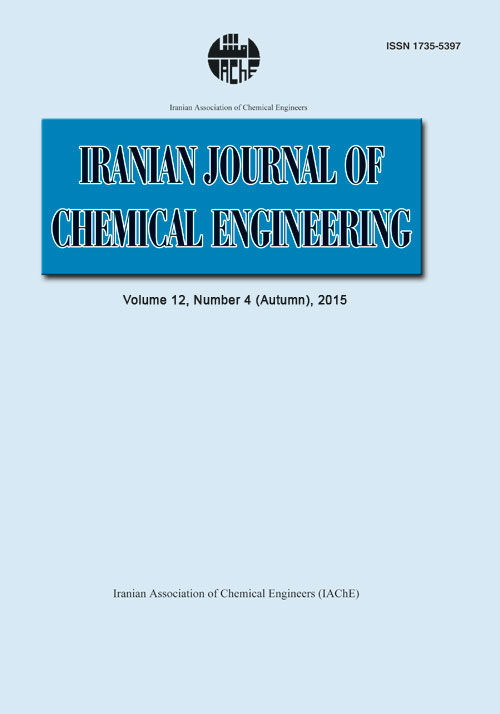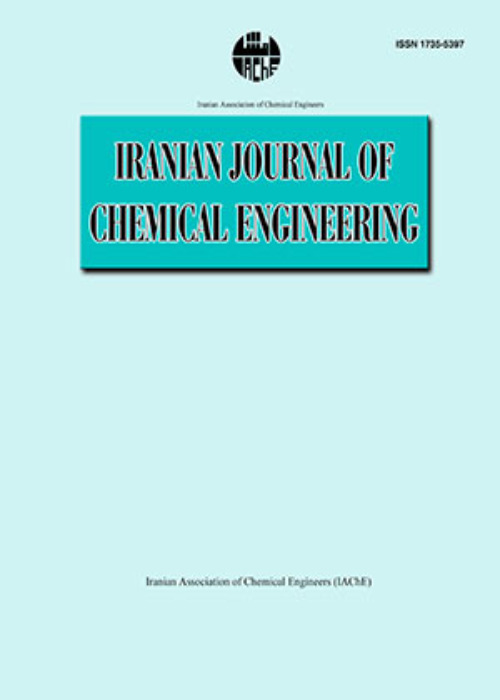فهرست مطالب

Iranian journal of chemical engineering
Volume:12 Issue: 4, Autumn 2015
- تاریخ انتشار: 1394/08/20
- تعداد عناوین: 8
-
-
Page 4The effects of templating on the catalytic performance of SAPO-34 catalyst have been investigated in conversion of methanol to olefins. SAPO-34 catalysts were synthesized using a different combination of morphine, tetraethyl ammonium hydroxide (TEAOH) and triethylamine (TEA) as structure-directing agents during synthesis of gel with nominal composition as 1Al2O3:1P2O5:0.4SiO2:2yTEAOH:2xTEA:2(1-(x+y))morpholine:70H2O. The different SAPO-34 samples were characterized by XRD, SEM, FTIR, BET, EDX and TPD techniques. Increasing TEAOH in synthesis gel led to decreasing mean crystal size. The catalytic performance of the synthesized catalysts was tested in MTO reaction at 410C and a feed WHSV of 6.5 1/h. The catalyst synthesized by combination of tri-templates exhibited highest light olefins yield in 100% methanol conversion. The optimum values (X=0.17, Y=0.34) were obtained by central composite design and response surface contour plots.Keywords: MTO Reaction, Light Olefin, SAPO, 34, Template
-
Page 15Current drug-eluting stent (DES) technology is not optimized with regard to the pharmacokinetics of drug release, more research on the drug-eluting stent design and flux of drug release to the arterial wall is necessary. Considering a three-dimensional (3D) cylindrical mathematical model, a novel free drug mass transfer release has been formulated and applied for better estimation of the drug concentration in the tissue. The transport equations involved both convection and diffusion equations. Besides, a reversible reaction in the arterial wall was considered. The present model was solved by an appropriate numerical simulation method and the predicted results were compared with in vivo data. To find out the rate-limiting step, the time scale analysis was also applied. The obtained results showed that the binding process is more limited by convection and diffusion, where convection is the rate-controlling step. It is also demonstrated that the presented approach has advantages over the prior free drug mass transfer models, including better data prediction and satisfying mass transfer consistency.Keywords: Drug Eluting Stent, Three, Dimensional Model, Free Drug Mass Transfer, Reversible Binding, Limiting Step
-
Page 28A high performance activated carbon was synthesized using walnut shell as a solid waste through a two-step zinc chloride chemical activation-thermal pyrolysis process. Characterization results demonstrated its porous structure with very good textural properties such as high BET surface area (1223 m2/g) and high total pore volume (0.85 cm3/g). The final adsorbent was used for adsorption of Fe (II) and Cr (VI) from aqueous solution. Effect of pH, initial concentration of metal ions, temperature, and contact time on adsorption capacity of the adsorbent was investigated. Adsorption results revealed that the maximum removal of Fe (II) and Cr (VI) ions, occurred at pH 4.5 and 2 respectively, were 96.2% and 99% at 313K. The equilibrium and kinetics data for adsorption of single-component ions were well described by the Sips isotherm and the pseudo-nth-order models, respectively. The impact of competing ions was studied by adsorption of a binary solution of Fe (II) and Cr (VI) ions. The binary adsorption isotherm was described by the modified Langmuir model and model parameters were found following an optimization procedure by genetic algorithm. Finally, the developed walnut-shell based activated carbon showed higher adsorption efficiency compared to other activated carbons at similar conditions.Keywords: Heavy Metal, Adsorption, Activated Carbon, Walnut Shell, Isotherm
-
Page 52After fullerene and nanotubes, graphene is a new allotrope of carbon. This attractive nanomaterial can be produced by different methods. In this work, we have used the less common approach for preparation of graphene. This technique is based on the utilization of supercritical fluid. Ethanol was used as the solvent for exfoliation of pristine graphite, at the temperature of 400 oC and pressure of 40 MPa. In addition, supercritical ethanol was used to reduce and exfoliate graphite oxide. FT-IR spectra indicate that reduction and exfoliation of graphite oxide can be done in supercritical ethanol, simultaneously. Effect of graphite oxidation on the yield and quality of graphene was investigated and results showed that oxidation of graphite can improve the yield of supercritical process from 12.5% to 26.8%, but Raman spectra revealed that quality of graphene samples produced by graphite oxide is lower than neat graphite. Moreover, the impacts of initial graphite concentration and sonication power on the exfoliation yield were studied. Finally, hybrid structure of graphene and titanium dioxide nanoparticles were prepared by ultrasonic method and used for photocatalytic degradation of methylene blue dye pollutant. Results revealed that titanium dioxide nanoparticles show better photocatalytic performance in presence of graphene sheets.Keywords: Graphene, Graphite, Supercritical Exfoliation, Graphite Oxide, Photocatalytic Degradation
-
Page 69Polysulfone/carbon nanotubes (PSF/CNTs) nanocomposite membrane was prepared via phase inversion induced by immersion precipitation technique. In addition, the surface of the CNTs was functionalized by polar carboxylic and amine groups to improve the interaction between the CNTs and the polymer matrix. For this purpose, the neat CNTs were chemically treated using sulfuric acid/nitric acid (H2SO4/HNO3) mixture and an aromatic amine agent, i.e. 1-4-diamino benzene (DABZ), to produce the functional groups on the CNTs surface. The Fourier transform infrared (FTIR) spectra indicated the presence of carboxylic- and amine-functional groups on the nanotubes surface. Asymmetric PSF composite membrane with various levels of the functionalized CNTs were prepared to investigate the effect of functional group type on the morphology and water flux rate of the resulting membranes. The results showed that the incorporation of the functionalized CNTs up to 0.5 wt% increased the pore size and surface roughness of the sheet membranes, while further addition decreased porosity and roughness. Higher water flux rate was observed for the amine-functionalized CNTs (af-CNTs) reinforced PSF membrane when compared with the membranes reinforced with the carboxyl-functionalized CNTs (cf-CNTs). The stronger compatibility between af-CNTs and the PSF matrix caused higher water permeability. The salt rejection performance of these microfiltration composite membranes was evaluated.Keywords: Asymmetric Membrane, CNTs, Polysulfone, Functionalization, Morphology
-
Page 84In this research, unstructured kinetic modeling for cell growth evaluation by X.campestris, xanthan production and sugar cane molasses consumption in a batch culture were investigated. Logistic model for biomass growth, Luedeking-Piret model for xanthan biopolymer production and modified Luedeking-Piret model for sugar cane molasses consumption provides an accurate prediction of the fermentation kinetic parameters with high coefficient of determination R2 values. Luedeking-Piret model for xanthan biopolymer production in three different concentrations of sugar cane molasses (30, 60 and 90 g/L) as the sole carbon source substrate were studied. Good agreement between experimental and predicted values indicated that the unstructured models were able to describe this fermentation process successfully. The values of specific growth rate μ_max of logestic model for sugar cane molasses (30, 60 and 90 g/L) were 0.029, 0.031 and 0.032 1/h respectively. The values of α and β are 5.280, 6.594, 8.518 and 0.072, 0.066, 0.086 respectively, which shows that the xanthan production is growth associated since the value of the growth associated parameter α is much more than the value of nongrowth associated parameter β in Luedeking Piret model. Moreover, the values of γ and 𝜂 in modified Luedeking-Piret model were obtained.Keywords: Xanthan, Logestic Model, Cell Growth, Luedeking, Piret Model, Kinetics
-
Page 93Antioxidants have an important role in control and prevention of dangerous diseases like cancers, but instability and high solubility of the antioxidants are major challenges of pharmaceutical researchers. Thus, using a suitable carrier for an antioxidant can enhance the antioxidant stability and protect it from reacting with the other existing molecules in the blood circulation. Mesoporous silica nanoparticles (MSNs) have been widely used as a carrier for therapeutic applications because of their suitable biological properties. This study attempts to improve the surface properties and increase antioxidant loading by functionaliztion of MSNs with 3-aminopropyltriethoxysilane (AP-MSNs) via post- synthesis grafting method. Synthesized nanoparticles were characterized by Scanning electron microscopy (SEM), Zetasizer and Fourier transform infrared spectroscopy (FTIR). Gallic acid (GA) was loaded into AP-MSNs. To optimize GA loading capacity, two effective parameters: GA concentration and embedding time were investigated. So different concentrations of GA in EtOH (1-50 mg/mL) were prepared and sampling was done in 24 and 48 h. Results showed that the best GA loading capacity was obtained at a concentration of 40 mg/mL in 48 h. The maximum GA loading capacity and entrapment efficiency were obtained 46 and 20%, respectively, determined by spectrophotometry and high-performance liquid chromatography (HPLC) analysis.Keywords: Nanoparticle, Novel Drug Delivery, Mesoporous Silica, Functionalization, Gallic Acid
-
Page 101


